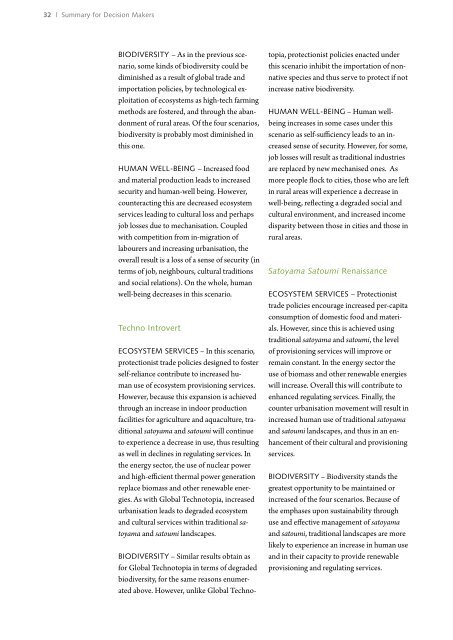Satoyama-Satoumi Ecosystems and Human Well-Being - UNU-IAS ...
Satoyama-Satoumi Ecosystems and Human Well-Being - UNU-IAS ...
Satoyama-Satoumi Ecosystems and Human Well-Being - UNU-IAS ...
You also want an ePaper? Increase the reach of your titles
YUMPU automatically turns print PDFs into web optimized ePapers that Google loves.
32 | Summary for Decision Makers<br />
Biodiversity – As in the previous scenario,<br />
some kinds of biodiversity could be<br />
diminished as a result of global trade <strong>and</strong><br />
importation policies, by technological exploitation<br />
of ecosystems as high-tech farming<br />
methods are fostered, <strong>and</strong> through the ab<strong>and</strong>onment<br />
of rural areas. Of the four scenarios,<br />
biodiversity is probably most diminished in<br />
this one.<br />
<strong>Human</strong> well-being – Increased food<br />
<strong>and</strong> material production leads to increased<br />
security <strong>and</strong> human-well being. However,<br />
counteracting this are decreased ecosystem<br />
services leading to cultural loss <strong>and</strong> perhaps<br />
job losses due to mechanisation. Coupled<br />
with competition from in-migration of<br />
labourers <strong>and</strong> increasing urbanisation, the<br />
overall result is a loss of a sense of security (in<br />
terms of job, neighbours, cultural traditions<br />
<strong>and</strong> social relations). On the whole, human<br />
well-being decreases in this scenario.<br />
Techno Introvert<br />
Ecosystem services – In this scenario,<br />
protectionist trade policies designed to foster<br />
self-reliance contribute to increased human<br />
use of ecosystem provisioning services.<br />
However, because this expansion is achieved<br />
through an increase in indoor production<br />
facilities for agriculture <strong>and</strong> aquaculture, traditional<br />
satoyama <strong>and</strong> satoumi will continue<br />
to experience a decrease in use, thus resulting<br />
as well in declines in regulating services. In<br />
the energy sector, the use of nuclear power<br />
<strong>and</strong> high-efficient thermal power generation<br />
replace biomass <strong>and</strong> other renewable energies.<br />
As with Global Technotopia, increased<br />
urbanisation leads to degraded ecosystem<br />
<strong>and</strong> cultural services within traditional satoyama<br />
<strong>and</strong> satoumi l<strong>and</strong>scapes.<br />
Biodiversity – Similar results obtain as<br />
for Global Technotopia in terms of degraded<br />
biodiversity, for the same reasons enumerated<br />
above. However, unlike Global Techno-<br />
topia, protectionist policies enacted under<br />
this scenario inhibit the importation of nonnative<br />
species <strong>and</strong> thus serve to protect if not<br />
increase native biodiversity.<br />
<strong>Human</strong> well-being – <strong>Human</strong> wellbeing<br />
increases in some cases under this<br />
scenario as self-sufficiency leads to an increased<br />
sense of security. However, for some,<br />
job losses will result as traditional industries<br />
are replaced by new mechanised ones. As<br />
more people flock to cities, those who are left<br />
in rural areas will experience a decrease in<br />
well-being, reflecting a degraded social <strong>and</strong><br />
cultural environment, <strong>and</strong> increased income<br />
disparity between those in cities <strong>and</strong> those in<br />
rural areas.<br />
<strong>Satoyama</strong> <strong>Satoumi</strong> Renaissance<br />
Ecosystem services – Protectionist<br />
trade policies encourage increased per-capita<br />
consumption of domestic food <strong>and</strong> materials.<br />
However, since this is achieved using<br />
traditional satoyama <strong>and</strong> satoumi, the level<br />
of provisioning services will improve or<br />
remain constant. In the energy sector the<br />
use of biomass <strong>and</strong> other renewable energies<br />
will increase. Overall this will contribute to<br />
enhanced regulating services. Finally, the<br />
counter urbanisation movement will result in<br />
increased human use of traditional satoyama<br />
<strong>and</strong> satoumi l<strong>and</strong>scapes, <strong>and</strong> thus in an enhancement<br />
of their cultural <strong>and</strong> provisioning<br />
services.<br />
Biodiversity – Biodiversity st<strong>and</strong>s the<br />
greatest opportunity to be maintained or<br />
increased of the four scenarios. Because of<br />
the emphases upon sustainability through<br />
use <strong>and</strong> effective management of satoyama<br />
<strong>and</strong> satoumi, traditional l<strong>and</strong>scapes are more<br />
likely to experience an increase in human use<br />
<strong>and</strong> in their capacity to provide renewable<br />
provisioning <strong>and</strong> regulating services.
















